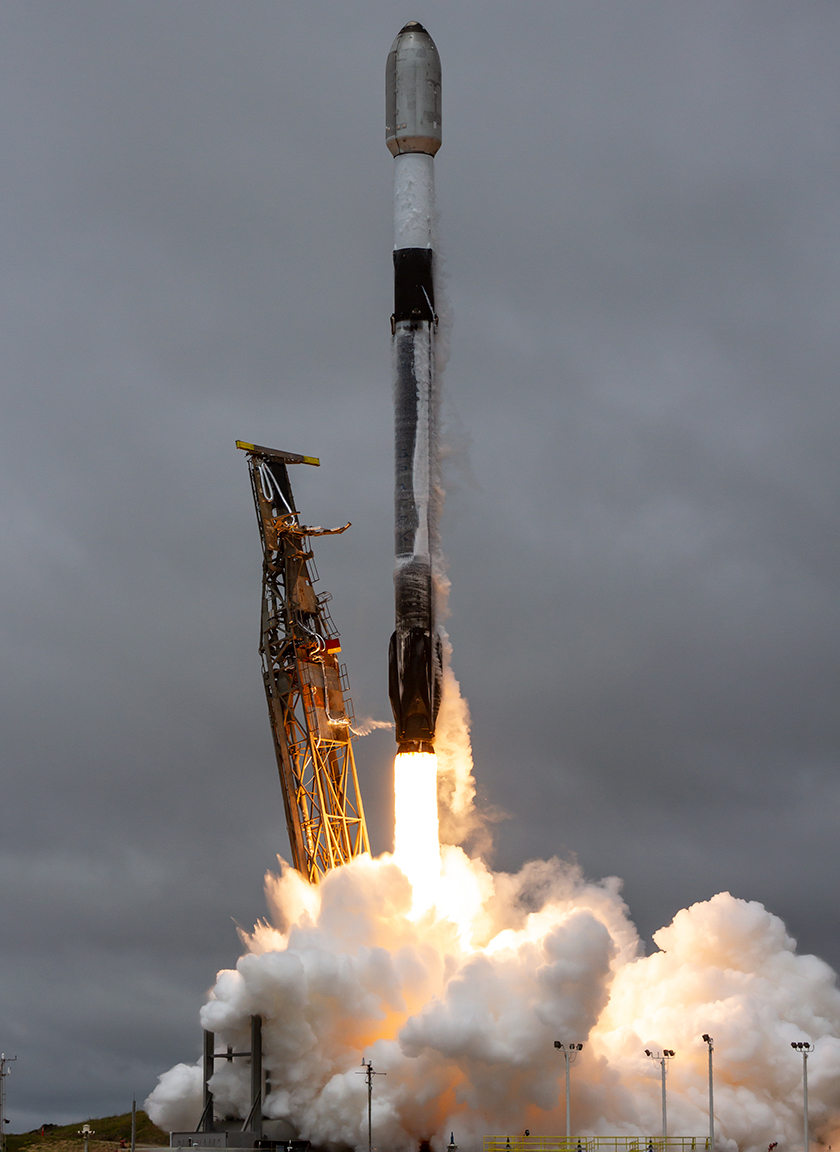The Space Weather Innovation, Measurement, Modelling and Risk (SWIMMR) programme is a five-year, £20 million investment by the UK Research and Innovation (UKRI) Strategic Priorities Fund.
The UKRI SWIMMR-1 instrument, HardPix, procured from the Czech Technical University, was launched from Vandenberg Air Base, California, aboard the D-Orbit satellite carrier ION SCV011.
It is part of a rideshare mission called Transporter 8, launched by a SpaceX Falcon 9 rocket.

SWIMMR-1 Launched on a Space X Falcon 9 Rocket from California. Credit: SpaceX
Supplying radiation data
The UKRI SWIMMR-1 instrument will supply radiation data (energised charged particles) from an altitude of 645 kilometres (km) to the Met Office Space Weather Operations Centre.
Within the SWIMMR programme, the S1 'Improved in-situ radiation measurements for space and aviation' project is being implemented by the Space Physics and Operations Division of Science and Technology Facilities Council (STFC) RAL Space. The project has support from expert subcontractors including a consortium led by Inverse Quanta Limited.
D-Orbit won the SWIMMR S1 Trusted Space In-orbit Monitoring Mission tender to provide in-situ radiation data from space.
Protecting vital infrastructure
Space weather occurs when the Sun releases magnetic fields, electrically charged particles, and radiation, into space.
These are carried through the solar system, including towards Earth.
If this radiation interacts with technological infrastructure such as satellites, it can disrupt their functionality, compromising vital services such as satellite navigation.
This can pose a significant risk to the technologies we rely on in daily life and those designing such infrastructures need to take space weather into account when designing robust systems.
Significant risks
These risks are recorded in the UK government's national risk register with severe space weather recognised as a significant risk.
The UK government's plan to increase preparedness and resilience to a severe space weather event is outlined in its severe space weather preparedness strategy.
The strategy highlights radiation monitoring using sensors such as UKRI SWIMMR-1 as an important mitigation.
New capabilities and approaches
The SWIMMR Programme Manager, Dr Ian McCrea, said: “Radiation hazards to spacecraft are among the most high-profile space weather risks and a key focus of the government's severe space weather preparedness strategy.
“Radiation damage can stop electronic components working and rapidly age others.
“With this mission, we are demonstrating new capabilities such as platform rentals, ride sharing and off-the-shelf sensors.
“These new approaches can offer to support the radiation monitoring requirements of the future and will be key to resilience for developing aspects of the space industry."
Addressing an urgent need
Despite the significance of data collected from satellites in-orbit to understand and monitor the risks of severe space weather, there is currently a limited availability of sustained radiation measurements.
This data holds immense importance given the increase of satellites operating in similar orbits to the UKRI SWIMMR-1 mission.
The instrument is anticipated to begin providing energetic particle data about the radiation environment at a 645km altitude while in its sun-synchronous high-inclination circular orbit.
Successful operation of this first mission will not only provide the initial data but this mission will also act as a precursor for a future launch that will:
- take data from higher altitudes
- demonstrate the operation of an overall space weather monitoring system, including how the energetic particle data is provided to the Met Office
Accurate models and predictions
Met Office Space Weather Manager, Simon Machin, said: “This mission will enhance our ability to accurately model and predict severe space weather activity.
“Radiation data from the UKRI SWIMMR-1 instrument will underpin the future delivery of more accurate and reliable forecasts to satellite operators.
“We look forward to continuing to work with STFC and RAL Space on future missions which will further enhance our capability in space weather forecasting."
Further information
UKRI funds a range of research to support UK and international space weather preparedness.
Most notably, the SWIMMR programme is a five-year, £20 million investment by the UKRI Strategic Priorities Fund Wave 2, made up of 11 diverse space weather research projects.
These projects are managed by STFC and the Natural Environment Research Council. They include the S1 'Improved in-situ radiation measurements for space and aviation' project among other exciting initiatives to improve UK:
- monitoring
- modelling
- prediction of space weather risks
Together, they are enhancing the UK's ability to deliver warnings, forecasts and advice pertinent to various critical concerns from space weather effects on:
- satellites, spaceflight, and aircraft
- communication and global positioning system
- ground-based infrastructure such as power grids
